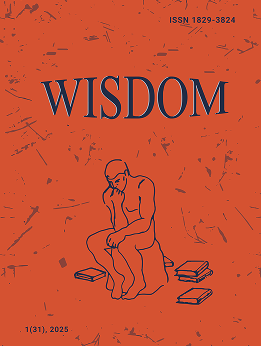Functional, Semantic and Linguistic Features of Latin Text on Vanitas Works of Fine Art
DOI:
https://doi.org/10.24234/wisdom.v19i3.527Keywords:
Vanitas genre, Latin inscriptions, semantic and functional features, linguistic features, sources of borrowingAbstract
The article presents the results of a study of Latin inscriptions on paintings and engravings of the Vanitas genre. The sources of borrowing citations, their functional-semantic and linguistic load are analysed. The research proves that texts in Latin are an integral part of paintings and engravings of the Vanitas genre, and their use is conditioned by the specifics of the origin and historical development of the genre. The analysis of Latin inscriptions helps form a generalised vision and perception of the world's vanity, the transience of life, and the inevitability of death, which is laid down by artists in their works. The contemplation of such works is designed to inspire viewers with the idea that everything that surrounds and accompanies a person in this life is vanity. Also, there is a significant difference between the death of a person who lives righteously and the death of a sinner. The artists used Latin quotes from various sources to enhance their influence on the audience (the quotes from the Bible and works of ancient authors). Quotes from the works of contemporaries are used less frequently. Artists were relatively free with the quoted phrases: they shortened, supplemented, and combined expressions.
Downloads
References
Biblia Sacra Vulgata (Vulgate Holy Bible, in Latin). (n. d.). Retrieved from https://www.biblegateway.com/
Blesensis, P. (1847). Opera Omnia (All Works, in Latin). Oxonii: I.†H. Parker. Retrieved from https://archive.org/details/petriblesensisba02pete/page/n13/mode/2up
Brechtus, L. (1556). Euripus (Euripus, in Latin). Joannes Waen. Retrieved from https://bit.ly/3qYI6jr.
Cheney, L. (2018). The symbolism of the skull in Vanitas: Homo Bulla Est. Cultural and Religious Studies, 6(5), 267-284. doi: 10.17265/2328-2177/2018.05.001
Common English Bible. (n. d.). Retrieved from https://www.biblegateway.com/
Granada, F. L. de (1582). Collectanea moralis philosophiae (Disquisitions on moral philosophy, in Latin). Parisiis: Chaudiere.
Greek and Roman Materials. (n.†d.). Retrieved from https://bit.ly/3AWmCIw
Gruznova, A. A. (2018). Tema ìvanitasî v natyurmortakh s atributami voiny i vlasti v harlemskoi shkole v pervoi polovine XVII veka (The theme of ìvanitasî in still lifes with the attributes of war and power in the Harlem school in the first half of the 17th century, in Russian). ARTIKULíT, 30(2), 36-40.
Hall, J. (1974). Dictionary of Subjects and Symbols in Art. New York. Evanston. San Francisco. London: Icon editions Harper & Row, Publishers. Retrieved from https://bit.ly/3ibrEZd
Hieronymus (n.†d.). Epistulae (Letters, in Latin). Retrieved from https://bit.ly/3xwWlOO
Hildebertus, V. (n.†d.). Carmina Miscellanea (Miscellaneous songs, in Latin). Retrieved from https://bit.ly/3yQR9Wq
Junius, H. (1598). PoÎmatum liber primus (The first book of poems, in Latin). Lugduni: L. Elzevirius. Retrieved from https://bit.ly/3ecERzx
Kempis, Th. ‡. (n.†d.). De Imitatione Christi Liber Primus (The imitation of Christ: The first book, in Latin). Retrieved from https://www.thelatinlibrary.com/kempis/kempis1.shtml
Knˆll, S. A., & Oosterwijk, S. (Eds.) (2011). Mixed metaphors: The Danse Macabre in medieval and early modern Europe. Cambridge: Cambridge Scholars Publishing.
Merriam-Webster (n.d.). Calvinism. In Merriam-Webster dictionary. Retrieved from https://www.merriam-webster.com/dictionary/Calvinism
Merrill, D. O. (1960). The ìVanitasî of Jacques de Gheyn. Yale Art Gallery Bulletin, 25(3), 7-29. Retrieved from https://www.jstor.org/stable/40514012
Mori, Y. (1996). The iconography of homo bulla in Northern art from the sixteenth to the nineteenth centuries. In G.†G.†Bauer (Ed.), Homo ludens; der spielende Mensch (pp. 149-176). M¸nchen/Salzburg: Emil Katzbichler. Retrieved from https://bit.ly/2Vqvc1I
Ozerov, R. (n. d.). Raznovidnosti zhanra natyurmort (Varieties of the still life genre, in Russian). Retrieved from https://www.art-spb.ru/article/329
Parallel Latin / English Psalter (n.†d.). Retrieved from http://medievalist.net/psalmstxt/
Piorko, M. (2014). Nothing good without pain: Hans Memlingís earthly vanity and divine salvation. (MA Thesis, Georgia State University). Retrieved from https://bit.ly/3ebSVt3
RuÌz S·nchez, M. (2006). Pulvis et umbra. A propÛsito de algunos paralelos neolatinos de un famosÌsimo verso de gÛngora (Dust and shadow. On the subject of some neo-Latin parallels of a famous gÛngora verse, in Spanish). Myrtia, 21, 317-328. Retrieved from https://bit.ly/2UJUDLh
Shherbinina, Ju. (2019). Pomni o smerti. Knigi v natyurmortakh vanitas (Remember death. Books in vanitas still lifes, in Russian). Retrieved from https://gorky.media/context/pomni-o-smerti/
The Holy Bible: RSVCE (Revised Standard Version Catholic Edition). (n.d.). Retrieved from https://www.biblegateway.com/
Vanitas (n.d.). Retrieved from https://www.tate.org.uk/art/art-terms/v/vanitas
Woodall, J., & Porras, S. (2015). Picturing the Netherlandish Canon. London: The Courtauld Institute of Art. Retrieved from https://bit.ly/3yLQ4Ph
Downloads
Published
How to Cite
Issue
Section
License
Copyright (c) 2021 Author and scientific journal WISDOM

This work is licensed under a Creative Commons Attribution-NonCommercial 4.0 International License.
Creative Commons Attribution-Non-Commercial (CC BY-NC). CC BY-NC allows users to copy and distribute the article, provided this is not done for commercial purposes. The users may adapt – remix, transform, and build upon the material giving appropriate credit, and providing a link to the license. The full details of the license are available at https://creativecommons.org/licenses/by-nc/4.0/.















